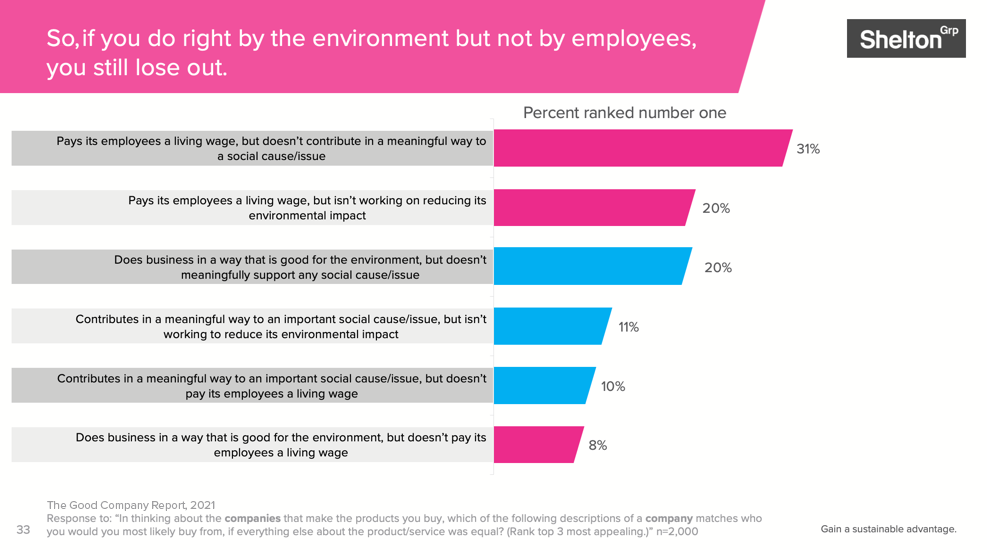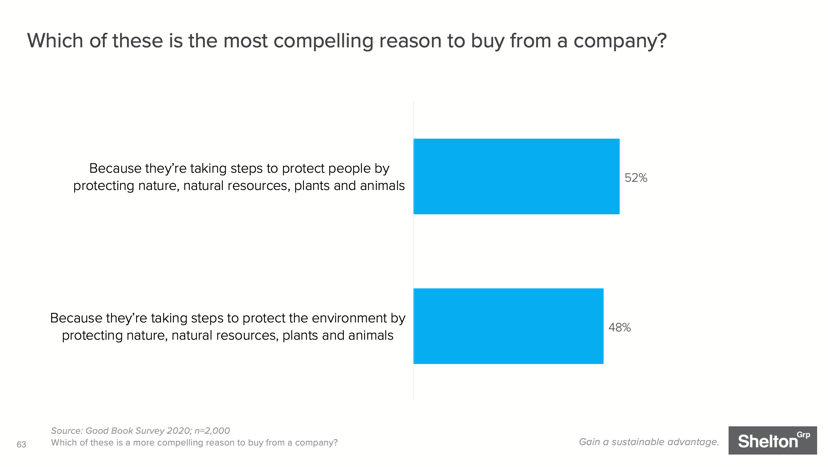Two things companies must do to create real change
Shelton Stat of the Week
10% of people in America say one of the top three things companies should do to influence their purchase decision is to “reduce greenhouse gas emissions,” while twice that number (20%) say “recycle.”
— Eco Pulse®, Fall 2020
For a long time, I believed that if we could just make every product at shelf better, then people could just keep buying what they wanted and we wouldn’t have to undergo the Herculean task of changing their behavior.
I do still believe we should make every product at shelf better, but I no longer believe we can absolve everyday folks of their responsibility to change behaviors to create a sustainable future. The climate challenge is just so big, so urgent and so all-encompassing (we are indeed talking about the displacement of hundreds of millions of people, ecosystem collapses and mass extinctions upon which entire food systems depend), we need all hands on deck. Governments, companies and consumers alike all need to change in order to confront, manage and adapt to the climate crisis we’re already in the midst of.
I’ve been writing and speaking a lot lately about how companies need to move people in America beyond the mental model of eco-friendly = recycling. Shelton Group’s ongoing data bears out – over and over and over again – that what folks in this country most want to hear from companies in order to influence their purchase decision is that their products and packages are recyclable and contain recycled content. As a sustainability marketing communications firm with 16 years of such proprietary data at our fingertips, we’ve long advised our clients to lean into that. Give the people what they want! And then tell that story to drive preference and purchase.
But as the climate crisis gets more dire, Shelton Group is advising companies to go beyond that. Yes, create a circular model and tell that story, but also bring consumers along to a broader understanding of eco-friendliness to include the fight to manage climate change, what your company is doing and what everyday folks need to do as well. Again, it’s an all-hands-on-deck kind of fight, and, truly, companies should get credit for the hundreds of millions they’re spending to reduce their impacts. If consumers don’t appreciate that effort, it’s not leverageable. So, companies need to help consumers understand and appreciate it.
That’s the first thing companies must do to effect real change – for the greater good AND for their businesses – and you can read more about the data and rationale behind that recommendation here.
The second thing companies must do – which supports the first thing – is to help consumers understand the connection between people and the planet. People care most about people. Our 2021 Good Company report bore this out in spades. When asked, “What’s the number one thing a company should do to be considered good?” 28% said, “treat its employees well” and 20% said, “pay its employees a living wage.” The rest of the answers came in at single digits, so the message was far and away, “we care more about how companies treat people than we do about how they treat the planet.”
We saw this again in a forced choice question regarding corporate actions framed like: “they’re doing this, but not doing that…would you buy from them?” You can see the answers in the chart from our report included here. Here’s the gist: if you do great things for the environment but don’t treat employees well, you’re not going to be seen as a good company.

However, in the same study we asked the question, “Which of these is the best reason to buy from a company: Because they’re taking steps to protect people by protecting nature, natural resources, plants and animals OR because they’re taking steps to protect the environment by protecting nature, natural resources, plants and animals?” The answer was split, as you can see on the chart here. While people edged out environment, given how much preference for people we see in our other questions, we expected the people option to significantly outperform the environment option.

What this means is that people in America don’t understand the interconnection of people and planet. They’re not seeing that all of this sustainability and climate work isn’t really about saving the planet…it’s about saving the human race.
Now, we wouldn’t recommend that any company get that blunt in its messaging (it sounds rather scary and over the top). But, since we do know that generally people want to help and protect people, teaching them how you’re helping people with your work on climate, biodiversity and water (and on and on) is a winning approach for driving preference and loyalty. Again, your company is spending an incredible amount of money, time and effort to eliminate its environmental footprint, and you should get credit for it. And the two ways you can do that are to:
- Expand consumers’ mental models of eco-friendliness to include recycling AND fighting climate change.
- Connect the dots between what you’re doing for the planet and the very real benefits it has for people.
And while you’re messaging all of that and building loyalty, you’ll also be pulling everyday people into the important work we must all do to create a sustainable future.

— Food Business News
Younger generations are asking for ESG. When looking at opportunities to connect environmental action to people, one of the most direct comes from our food. This Food Business News article details what ESG actions Gen Z is looking for from the food industry and where your company can look to better connect with them.

ESG reports, unlike financial statements, are evolving rapidly to reflect a changing world
— The Economic Times
As ESG reporting continues to rise, it’s a great opportunity to bridge the gap between people and the planet. This Economic Times article explores how ESG reporting is adapting to new demands and pressures.
What Is Home? – Why security is joining comfort as one of the strongest drivers for home upgrades
It’s even affected how we think about safety and security! (Hint: it’s not primarily about security systems.) Businesses in the residential building sector that don’t understand these changes risk losing touch with their key audiences.
Our latest free report explores the new intersection of comfort, safety and health at home — and the implications for your brand’s messaging strategy.
Don’t miss this opportunity to deepen your emotional connection with consumers. After all, “home is where the heart is.”


-
-
TAGS:Corporate Sustainability, Energy & Environmental Marketing